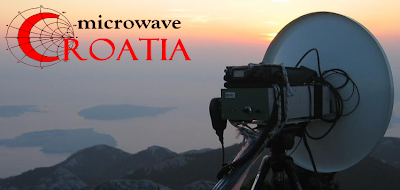As I required some descent L.O. signal for my NOTARS-C transverter the easiest way was to use my Si-4133 synthesizer. The upper limit for the synthesizer is roughly 2 GHz so some kind of a simple multiplier was required. No tune multiplier as a solution can be handy (same approach as 5.7GHz multiplier) but then I will be constrained to narrow selection of L.O frequencies. Possibility to tune to various frequencies was much better cause I want to test my NOTARS-C using both, high and low side injection with IF on 144 and 432 MHz. Between several possibility, the pipe cap filter was a "best buy" option. Simple, cheap, easy to tune and not taking so much time to fabricate one.
Looking around the "acid house" i found some 3/4 pipe caps from some previous projects, so this was easy to pick up. Dead bug style is no option on microwave frequencies, so some kind of PCB is a must. Luckily I have a pile of commercial equipment PCBs where a piece was striped of with a 50ohm microstrip line. X-acto knife and a little bit of imagination and the PCB was ready. Not nice and tidy but sufficient for the quick and dirty project. The multiplier was built around two MMIC amplifiers. The first SNA-286 is running as a multiplier and the second one, ERA-5 is running as amplifier. Of course, some other MMIC can be used instead, but it is wise to use the MMICs that are working on the frequencies of interest. In my case, both MMICs are good up to 6 GHz so there should be no problem at C band at all.
To force the first MMIC to act as a multiplier it is essential to saturate the MMIC just enough to produce reach harmonics. Do not push higher than maximum input power is allowed according the data sheet (dBm). I found that levels from 4-5dBm are working very good for this purposes. The higher input level will not always insure the higher output on desired harmonic frequency. Same goes for the Rb bias resistor. Increasing the value over the 80 ohm can give as a higher output level on desired harmonics too. This should be found by experiment. Do not go lower than 80 ohms because this Rb value will insure the highest allowed bias current. I found 100 ohms value to be handy for all frequencies from 2 up to 7 GHz. After filtering the required harmonic frequency with the pipe cap filter the signal is amplified with the second MMIC, ERA-5 which produce high and stable gain up to 6 Ghz. The output at 3836 Mhz was 17.6 dBm in my case, more then expected.
The pipe cap construction was straightforward. There is not much to explain, the design is quite simple. The dimensions of 3/4" are standard. In Europe they are sold under marking "22". I found the type "Vieaga 22" 22 stands for inner pipe cap diameter in mm. Inner height is 18 mm. For probes I used simple copper wire, 0.6 mm dia. Length inside the pipe cap was 8 mm and the distance between the probes was 12.7 mm. 3/4" pipe cap will give us the possibility to tune the filter from 2 up to 7 Ghz roughly. The peak on 3896 MHz was very strong and easily found, tuned with the M4 screw.
Pipe cap filter was a good choice. The signal was clean on required frequency. At the same time the attenuation was enough on the higher harmonics not to cause any problems. Tuning around the C-band was really easy and not sharp making no problem to distinguish the 144 and 432 Mhz IF frequency. Tuning on higher harmonics other then 2nd was also easy. I manage to tune the filter even on the 4th harmonic, of course with the reduced output, but still usable and clean signal.
After all, the multiplier came out as small and handy solution. This one will probably end up as a small C-band beacon.





.JPG)
.JPG)